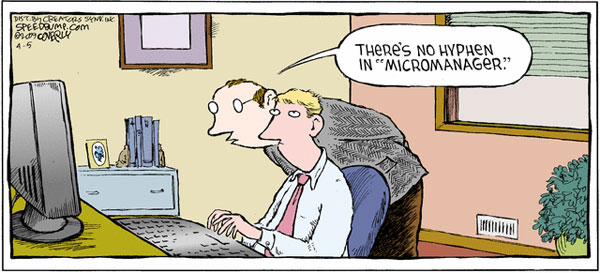Have you ever worked for a leader who is a horrible communicator? No one trained him, and it showed. For example, I worked for one leader who did not know how to clearly communicate. He knew it, I knew it, everyone knew it. The organization put this leader in charge of a big change initiative. He floundered, and we all suffered while this leader struggled. He did not know how to clearly communicate. All his stakeholders were left in the dark wondering what was happening. As you might imagine – it was a painful experience for all of us.

It is tough working for a leader who cannot clearly communicate
Another time I worked for a leader who was a daily disaster when it came to communications. He would speak at meetings, and everyone would cringe. No one was quite sure what in the world he was talking about, and neither was he. The organization ended up in complete chaos as a result of this leader’s inability to communicate and connect with his followers. At times he would explode in a meeting chastising his team for not doing things the way he wanted. Getting angry did not help the situation.

The leader who replaced him was much better at communicating
Eventually, a new leader was put in place. This leader went to work right away fixing the communication problems plaguing the organization. She was an engaging speaker. She made sure all of her meetings had a clear agenda to include opening and closing comments that she prepared in advance. Her team understood what she wanted. Trust was restored. Performance improved rapidly. I watched in wonder as she turned around a bad situation in less than 90 days. It was a pleasure working for a leader who knew how to clearly communicate and connect with her followers.
The difference between mere management and leadership is communication.
Sir Winston Churchill
A novel framework for new leaders
All The Way Leadership! created a novel framework for new leaders. Fundamentally this framework communicates that it is vital for you to possess integrated integrity as a new leader. Having individual integrated integrity means that ‘who you are’ aligns with ‘what you say’ and ‘what you do’. If you do not demonstrate individual integrated integrity your team will not trust you, and your impact as a leader will be limited. ‘Who you are‘ was covered in previous posts. Now ‘what you say’ will be discussed.

Three key components comprise ‘what you say’
All The Way Leadership! believes every leader needs to understand that ‘what you say’ is important. ‘What you say’ as a leader is comprised mainly of three key components – communicating with stakeholders, presenting your ideas, and engaging your team members. Communicating with stakeholders is the topic of this blog. It can be difficult to do, especially if you are a new leader. Also, many senior leaders have a diverse set of stakeholders that brings its own challenges. For now, let’s focus on a simple model for communicating with your stakeholders.

A tool to clearly communicate with your stakeholders
As a leader, it is important that you clearly communicate to your stakeholders. It sounds easy to do. It is not. The amount of miscommunication that occurs on a daily basis in most offices is enormous. Think about how many times this week you participated in a discussion that ended without a clear understanding of what you should do next. One tool to help you is a simple framework for thinking about the best method to communicate with your stakeholders. It is found below. Take some time to select the best method before communicating, not after the fact.

Selecting the best method to clearly communicate
All The Way Leadership! recommends that all leaders take the time to select the best method for communicating. Your stakeholders will thank you later. Four communication methods are found below.
- Face to face (in person) – some topics should be discussed in person. This method is best for direct communication. Conduct all crucial conversations in person, if possible. It may be impossible to talk with someone in person. A video teleconference is another option, although it is not the same since you can not read body language.
- Instant message – use this method for informal exchanges. It is especially effective if you need a quick answer to an easy question. IM is much more common as a workplace tool nowadays. I know some senior leaders who refuse to use IM. That is a mistake. Don’t be a dinosaur when it comes to IM.
- Text message – basically this is IM on your phone. Use this method if you have an immediate need or want to provide a quick update. For example, I will text someone if I am going to be late for a meeting.
- Phone (1 to 1) – use the phone for formal discussions that you cannot do in person. Some of your stakeholders may not like talking on the phone much. They may prefer IM. Let them know to answer when you call because it is usually important.

Two methods commonly used that cause the most problems
If you are a leader you are most likely participating in multiple group meetings and conference calls a day. You probably send and receive e-mails all day long. These two methods are effective but can cause problems if you are not thoughtful.
- Conference calls – an efficient method for group discussions. Several modern productivity tools make it easy to get a group together for a virtual meeting. If it is your meeting – lead the discussion. Don’t let it devolve into a circus. The video below is funny, but also accurate about what can happen during a conference call. Be prepared.
- E-mails – an effective method for both formal and informal communication with your stakeholders. It is a great way to loop others into a conversation and make virtual introductions. BTW – read your emails. How do you know what is happening if you have hundreds of unread emails? Don’t ignore your inbox and hope for the best.
Why selecting the proper method to clearly communicate matters
As a leader, you will participate in many different kinds of conversations. Some will be quick like getting a status update from one of your team members. Others will be more serious like sharing bad news with your boss. Take the time you need to select the proper method for clearly communicating with your stakeholders. For example, don’t talk about sensitive personal topics on a large conference call. Save that discussion for later when you can discuss the issue with the person directly. Trust me – selecting the proper method will save you many headaches. In the next blogs, I will share tactical tips and lessons learned about communicating with stakeholders.

What about you?
Do you pay attention to ‘what you say’ as a leader? Have you taken the time to identify the best method for clearly communicating with your stakeholders? If not, make the investment now. If so, you will enjoy the next few blogs. We are going to explore how to clearly communicate with your stakeholders to include points to ponder, tactical tips and lessons learned.
Great leaders communicate and great communicators lead.
Simon Simek
ATW! is designed to make you a better leader
I hope you join me on this journey to raise up the next generation of leaders. The world is in desperate need of more great leaders. Women and men who lead with confidence, clarity, and creativity. It’s time to become the leader that your world needs. Let’s go All The Way!









